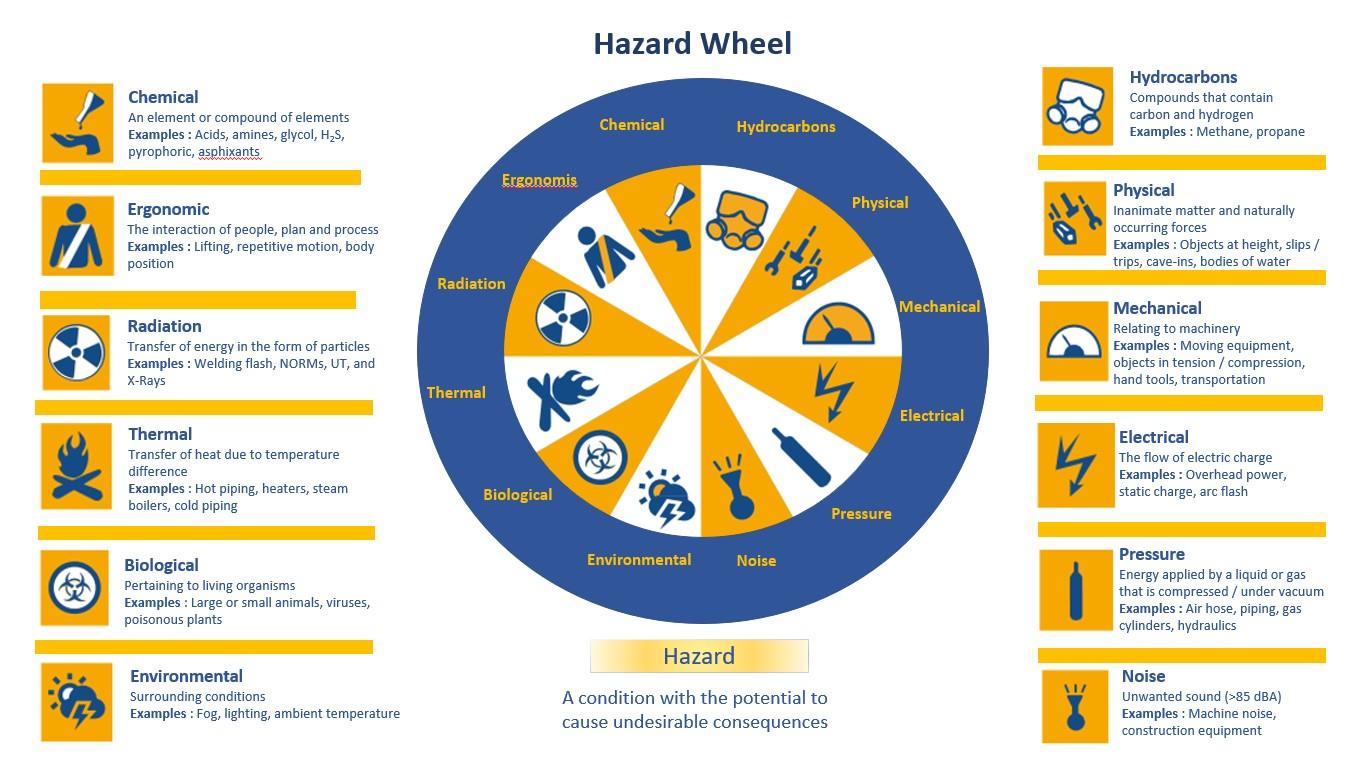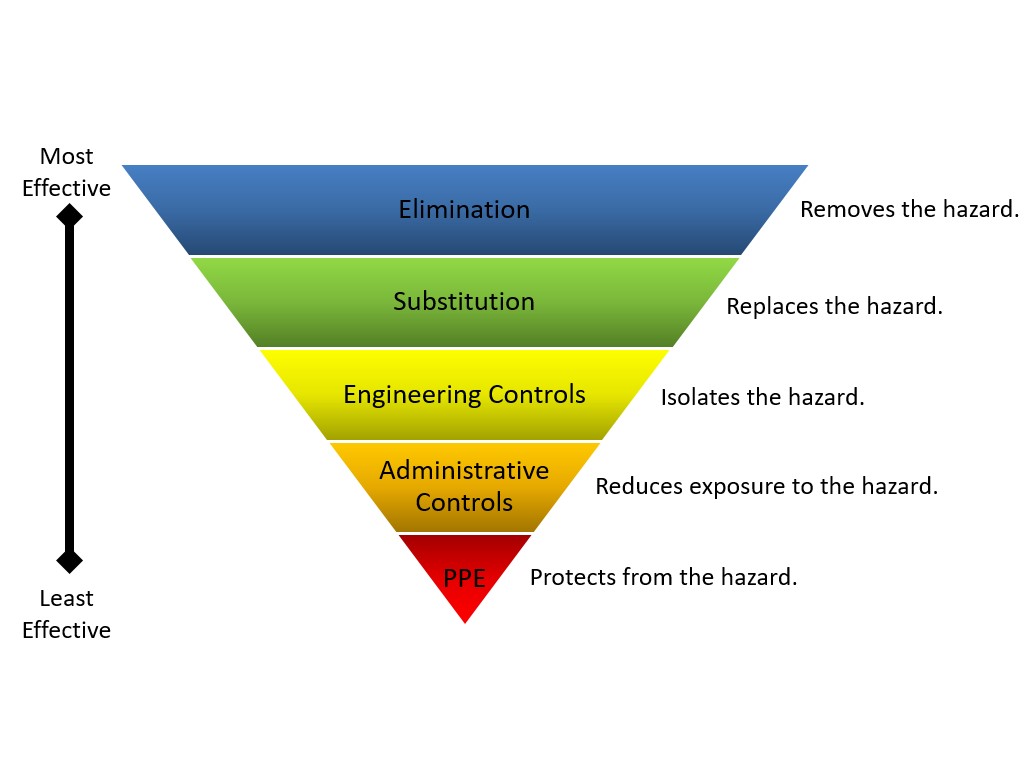Module 4.3 - Hazards at uOttawa
An employer the size of uOttawa will have an innumerable hazards to identify and control. As a worker, think about your daily route from entering your building to your office, workshop, or lab. Take a moment and think about how many hazards you encounter. Now think about the methods of risk reduction that protect you from those hazards. Remember – just because risk reduction measures exist doesn’t mean that hazards can’t reasonably be reduced even more. If you think a hazard requires further attention, report it to your supervisor for further investigation and corrective action.
Understanding the items, equipment, and processes around you helps to make the workplace a safer place. It is incumbent on everyone to identify hazards. While one person may have a different interpretation of what constitutes a hazard (perhaps because of their knowledge, experience, training, or the protective equipment provided), a strong internal responsibility system identifies sources of danger so that continual improvement can be made.
Hazards exist with:
- Lifting devices
- Confined or constricted spaces
- Chemical or biological materials
- Designated substances, such as lead, asbestos and mercury
- Lasers
- Vehicles
- Welding / cutting operations
- Pinch points and in-running nip hazards
- Sharp materials, such as scalpels, syringes, knives, or glassware
- Indoor air quality
- Radioactive materials
Hazard Identification
Hazard identification must consider reasonably foreseeable hazards that have the potential to cause harm to a worker. This includes all aspects of operations, including the physical components of equipment, the surrounding environment, foreseeable human factors (including misuse), cognitive limitations on the use of equipment or execution of the process, and all relevant phases of the process and/or operation. Remember that a hazard is the inherent property that can cause harm; therefore, hazards can exist anywhere.
The supervisor may also identify hazards by reviewing existing records (such as past incident reports), interviewing or observing employees, collecting workplace samples (e.g. direct, air, etc.), and checking other scientific data (e.g. safety data sheets).
The supervisor must also consider the potential combination of hazards and how they might interact and affect one another, which may create an entirely different hazard (e.g., A + B = C rather than A + B =AB).
Module 4.4 - Sources of exposure information
Exposure to a hazard is only part of the picture. You also need to consider the route of exposure (inhalation, absorption, ingestion, or injection), concentration, volume, frequency, duration, manner of interaction, and level of exiting hazard control. Paracelsus, “the father of toxicology”, is credited with the phrase “what is it that is not a poison? All things are poison and nothing is without poison. It is the dose only that makes a thing not a poison.” In other words, the amount of a substance to which a person is exposed is just as important as the substance itself. For example, small doses of common medication can be beneficial to a person for minor health ailments, whereas large doses of the same medication could cause significant harm. In other cases, even small doses of the same medication could be hazardous to another person due to a medical predisposition.
Fortunately, workers, managers, and supervisors are not alone in determining toxicity. Resources are available, both internally and externally to the University. For example, let’s assume that an office will be refinished. The walls will be stripped and repainted. There are several sources of information that a worker, supervisor, and manager could rely on including:
The designated substances reports and hazardous materials survey for the building, which lists the known hazardous materials in infrastructure (such as asbestos, lead paint, etc.).
- The safety data sheet for the new paint.
- The Vertere chemical inventory, which lists the hazardous chemical products in use within the space (where applicable).
- Regulation 833, which outlines the exposure limits for hazardous chemical and biological agents.
- Medical surveillance processes for hazardous agents.
- Previous or active workplace sampling campaigns or modelling.
Perhaps the most useful takeaway from this section is that there is always more information available on the hazards encountered in the workplace. Workers, supervisors, and managers are required to collectively identify, evaluate, and control the hazards within their workspace. Internal resources are available when further assistance is required, including:
- Joint Health and Safety Committee
- Union or association
- Faculty’s Health, Safety and Risk Manager
Module 4.5 - Risks at uOttawa
Risk is the combination of the likelihood of the occurrence of harm and the severity of that harm, which is commonly expressed as risk = frequency x severity. Risk assessment is the overall process of hazard identification, risk analysis, risk estimation, and risk evaluation. That’s a lot of risks! Why do risk assessments need to be completed and regularly reviewed? Well, this video from the American Chemical Society provides the answer. Although this incident occurred in the context of a laboratory experiment, the message is applicable to all aspects of work.
Don’t worry too much about terminology: it’s the meaning of the terms that counts. Risk assessments are conducted in the following manner:
| Item | Definition | Process |
|---|
| Hazard identification | The process of finding, listing, and characterizing hazards | Hazards are identified that are (or could be) a source of danger to a worker. |
| Risk analysis | A process for comprehending the nature of hazards and determining the level of risk | Those hazards are analyzed to understand how those hazards affect the workplace, with greater attention and urgency paid to those that have the greatest potential for harm as well as those that are likely to occur more frequently. |
| Risk estimation | A process used to assign values to the likelihood and consequences of a risk | Those risks are estimated using pre-defined scales to quantify the frequency and severity of the risk, which reduces the subjective nature of the estimate. |
| Risk evaluation | The process of comparing an estimated risk against given risk criteria to determine the significance of the risk | The evaluation aims to formalize decisions about whether a particular work activities should be conducted, which risks needs to be further controlled, and the priority for addressing risks. Possible risk treatment options include: - Avoiding the risk.
- Reducing the risk.
- Transferring the risk.
- Accepting the risk.
|
The predefined scales to quantify risk need not be complicated, but they should represent the expected nature of both frequency and severity. For example, a simple risk matrix would include the scale (e.g. 1 to 5) as well as descriptors for the categories.
With risk assessed as frequency x severity, if a risk is likely (4) to occur and would result in major (4) consequences, that would yield a risk level of 16. The risk matrix places this on the high end of the risk scale, meaning that further risk control is probably required. The greater the risk level, the greater the attention required to address the issue.
Additional information about this process and its tools, such as job hazard analysis and project risk assessments, is available online. As a leading research institution pushing the boundaries of discovery, it is critical that risk assessments be conducted by a multi-disciplinary, competent team prior to the execution of leading-edge work. In a way, these assessments are already conducted as part of the purpose of the research:
- Researcher wants to study ABC.
- Expected outcomes may include X, Y and/or Z.
- Research proceeds and findings are recorded and later published.
It is important that the researcher consider the hazards and risks of the research as early in the project as possible, not only to understand and control the hazards and risks that may jeopardize the health and safety of project personnel, but also to avoid costly interruptions resulting from reasonably foreseeable risks.


